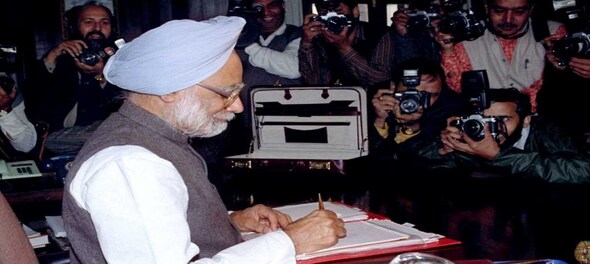
On July 24, we celebrate the 30th anniversary of the bold Manmohan Singh Budget of 1991, which along with equally bold industrial de-licencing and liberal trade policies, made a definitive break from the past and set the Indian economy on the path to growth.
Today as we look back at that dramatic July of 1991, the heart swells with pride that we had the courage to change and yet there is a distinct feeling that the changes should have gone deeper, wider and faster in the following decades.
But first the gains:
1. India's GDP growth surged from an average 3.5% pre-1991 to 5-6% in the 1990s, to 7-8% in the first decade of this century.
2. We created markets in place of administrative discretion: We ensured that markets set loan and deposit rates as also the exchange rate. We forced the government to borrow from the market at market-driven rates replacing a previous regime where governments helped themselves to nearly 35-40 percent of bank deposits at rates unconnected with inflation.
3. We created a competitive economy in many goods: We have been the third largest and consistently growing exporter country in Asia after China and Vietnam.
4. We evolved a sophisticated equity capital market: Complete with electronic paperless trading, and at least a 100 out of 6,000 listed companies that can compare with the best in the world.
5. Our banking system though creaky has a clutch of new private banks that are world class and a newly-establish digital payments system that is the envy of the world.
So, where are the shortfalls?
1. The biggest shortfall stares us in the face: health. Besides having the world's largest number of blind and undernourished children, economists Arvind Subramanian and Kaushik Basu point out that the percentage of stunted children in India which was falling (as a percentage of the population) until 2015, has started rising since that year.
The pandemic, of course exposed our pathetic health infrastructure. We rank 155th in the Human Development Index with only 12 countries worse off. India has just 8.6 doctors and 5 hospital beds for every 10,000 individuals of the population
2. The second biggest failure is education. A decent secondary school system plus world class engineering and management colleges were set up since 1950, but the momentum is nowhere up to what is needed. The churning out of cheap software engineers has helped India become a coding giant, and the IITs have ensured that most giant software companies in the world have an Indian at the top.
But quality education has remained restricted to the top 10 percent of India at best. The Annual Status of Education Report (ASER) test showed 56 percent of class eight students can't read or do basic math. The pandemic has pushed this bottom 60 percent of Indian students, further behind. India's is a problem of unemployment and unemployability.
3. A third constraint has been the legal-judicial system. The National Judicial Data Grid shows that currently a staggering 43.9 million cases are pending before the courts, up from 29 million in 2006. More than 4.5 million are pending for over 10 years, the same grid shows.
The delays are partly because of huge vacancies (of 1,080 positions in High Courts only 669 were filled, according to a recent report by Justice Madan Lokur), but even more because of the quality of judges. Judicial reforms are needed to ensure the best talent is attracted from the bar to the bench and the bench is allowed to remain responsible but independent. Both are increasingly decreasing.
4. Power and water are two basic necessities that haven't been reached to every Indian. Power distribution remains one of those unlicenced sectors, and are subject to the corruption and incompetence of impoverished state governments.
"Har Ghar Nal Se Jal" has been set as a motto by the current government. That this goal has been set 70 years after independence is tragic. What's worse is the coming climate crisis, which can make achieving this goal tough as resources get diverted to first conserving water before we have enough to distribute it.
5. Economic growth which was the biggest achievement of the reforms of the 1990s has now slowed, and shows signs of plateauing. In terms of per capita GDP India ranks 122, at less than $2,000 and this constrains availability of resources to deepen education health, electricity, water and opportunity to the bottom 80 percent of India. India's tax to GDP ratio remains among the lowest in the world.
6. The biggest shortfall finally is the polity. The political system, which once threw up reasonably strong institutions and ensured space for civil society is now often turning adversarial towards both constitutional institutions and civil society.
"We have miles to go before we sleep," as Dr Manmohan Singh eloquently puts it.
(Edited by : Jerome Anthony)
Check out our in-depth Market Coverage, Business News & get real-time Stock Market Updates on CNBC-TV18. Also, Watch our channels CNBC-TV18, CNBC Awaaz and CNBC Bajar Live on-the-go!


PM Modi visits Ram Mandir for first time since 'Pran Pratishtha', offers prayers before roadshow
May 5, 2024 8:59 PM
Visiting temples, obliging selfie requests, jabbing rivals – Kangana Ranaut is wooing voters on campaign trail
May 5, 2024 8:23 PM

